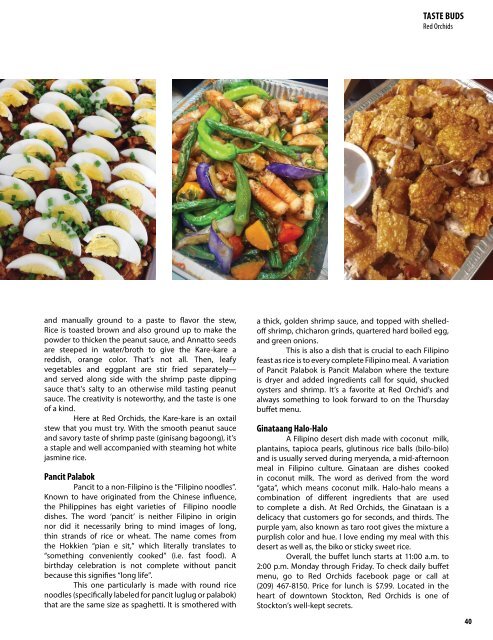You also want an ePaper? Increase the reach of your titles
YUMPU automatically turns print PDFs into web optimized ePapers that Google loves.
TASTE BUDS<br />
Red Orchids<br />
and manually ground to a paste to flavor the stew,<br />
Rice is toasted brown and also ground up to make the<br />
powder to thicken the peanut sauce, and Annatto seeds<br />
are steeped in water/broth to give the Kare-kare a<br />
reddish, orange color. That’s not all. Then, leafy<br />
vegetables and eggplant are stir fried separately—<br />
and served along side with the shrimp paste dipping<br />
sauce that’s salty to an otherwise mild tasting peanut<br />
sauce. The creativity is noteworthy, and the taste is one<br />
of a kind.<br />
Here at Red Orchids, the Kare-kare is an oxtail<br />
stew that you must try. With the smooth peanut sauce<br />
and savory taste of shrimp paste (ginisang bagoong), it’s<br />
a staple and well accompanied with steaming hot white<br />
jasmine rice.<br />
Pancit Palabok<br />
Pancit to a non-Filipino is the “Filipino noodles”.<br />
Known to have originated from the Chinese influence,<br />
the Philippines has eight varieties of Filipino noodle<br />
dishes. The word ‘pancit’ is neither Filipino in origin<br />
nor did it necessarily bring to mind images of long,<br />
thin strands of rice or wheat. The name comes from<br />
the Hokkien “pian e sit,” which literally translates to<br />
“something conveniently cooked” (i.e. fast food). A<br />
birthday celebration is not complete without pancit<br />
because this signifies “long life”.<br />
This one particularly is made with round rice<br />
noodles (specifically labeled for pancit luglug or palabok)<br />
that are the same size as spaghetti. It is smothered with<br />
a thick, golden shrimp sauce, and topped with shelledoff<br />
shrimp, chicharon grinds, quartered hard boiled egg,<br />
and green onions.<br />
This is also a dish that is crucial to each Filipino<br />
feast as rice is to every complete Filipino meal. A variation<br />
of Pancit Palabok is Pancit Malabon where the texture<br />
is dryer and added ingredients call for squid, shucked<br />
oysters and shrimp. It’s a favorite at Red Orchid’s and<br />
always something to look forward to on the Thursday<br />
buffet menu.<br />
Ginataang Halo-Halo<br />
A Filipino desert dish made with coconut milk,<br />
plantains, tapioca pearls, glutinous rice balls (bilo-bilo)<br />
and is usually served during meryenda, a mid-afternoon<br />
meal in Filipino culture. Ginataan are dishes cooked<br />
in coconut milk. The word as derived from the word<br />
“gata”, which means coconut milk. Halo-halo means a<br />
combination of different ingredients that are used<br />
to complete a dish. At Red Orchids, the Ginataan is a<br />
delicacy that customers go for seconds, and thirds. The<br />
purple yam, also known as taro root gives the mixture a<br />
purplish color and hue. I love ending my meal with this<br />
desert as well as, the biko or sticky sweet rice.<br />
Overall, the buffet lunch starts at 11:00 a.m. to<br />
2:00 p.m. Monday through Friday. To check daily buffet<br />
menu, go to Red Orchids facebook page or call at<br />
(209) 467-8150. Price for lunch is $7.99. Located in the<br />
heart of downtown Stockton, Red Orchids is one of<br />
Stockton’s well-kept secrets.<br />
40





